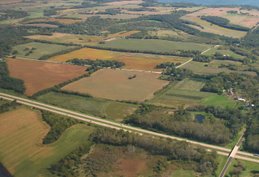Here is an illustration from Wisconsin Geological Survey's Ken Bradbury that shows that he knows the situation with the Eau Claire formation:

You can access this from:
http://www.nelson.wisc.edu/partnerships/programs/docs/bradbury_slideshow.pdf
The whole presentation is worthwhile to read, but the illustration above (from page 5 of this report) is a good summary.
A few things to observe here:
A few things to observe here:
1. A the base of the diagram is "Recambrian crystalline rock" -- note that it steadily rises from the west to the east; this rise in Precambrian bedrock is part of the Wisconsin Arch. The "Mount Simon aquifer" was formed largely by sand deposition by an ancient sea over this arch.
2. The "Eau Claire aquitard" (also call the Eau Claire "Confining unit" was deposited next by the ancient sea, but as the sea got shallower from west to east, the deposition of silt gradually changed to the deposition of sand as the sea reached the beach (the deeper quiet waters allow deposition of silt, which later becomes the "Eau Claire shale" but the shallow more turbulent shallow waters in the foreshore and shore areas deposit sand which later becomes sandstone.
3. The Eau Claire formation thus becomes thinner and thinner from west to east, even as it changes from having much silt (which forms the shale) to having less and less silt and more and more sand (which forms the sandstone).
4. As this thinning progresses from west to east, and as this shift from silt to sand occurs as the sea water becomes shallower to the west toward the shore, the quality of the Eau Claire formation as an aquitard (confining unit) becomes less and less.
5. Upshore from the water the Eau Claire formation disappears altogether.
6. This diminishing and disappearance of the Eau Claire formation is strongly accentuated by the ancient bedrock valley that cuts below the Eau Claire formation as it progresses from north to south---a valley that now contains the Yahara chain of lakes and glacial till deposits---a classic "buried bedrock valley."
The recent work of Wasinee Aswasereelert adds vital information to all of this, and has been published not only as her Master's dissertation in Geology at the University of Wisconsin-Madison, but also published as a refereed paper at: http://wisconsingeologicalsurvey.org/pdfs/geoscipdf/1_GS19.pdf
The recent work of Wasinee Aswasereelert adds vital information to all of this, and has been published not only as her Master's dissertation in Geology at the University of Wisconsin-Madison, but also published as a refereed paper at: http://wisconsingeologicalsurvey.org/pdfs/geoscipdf/1_GS19.pdf



No comments:
Post a Comment